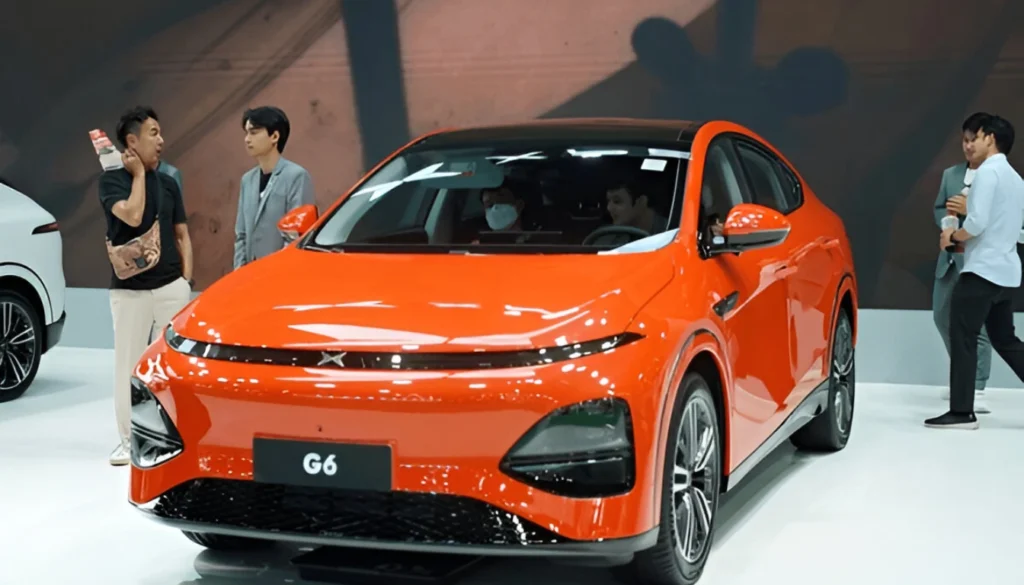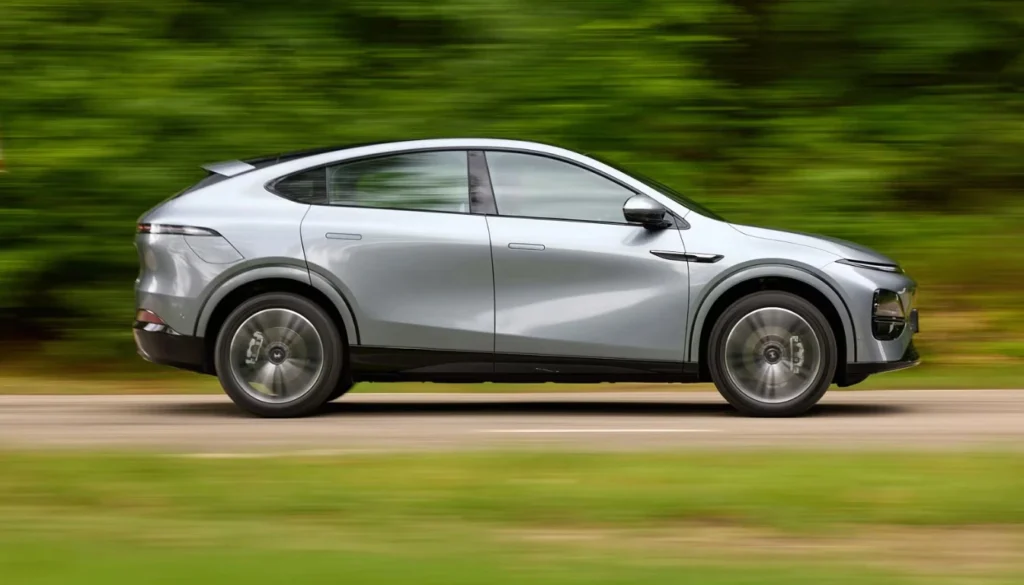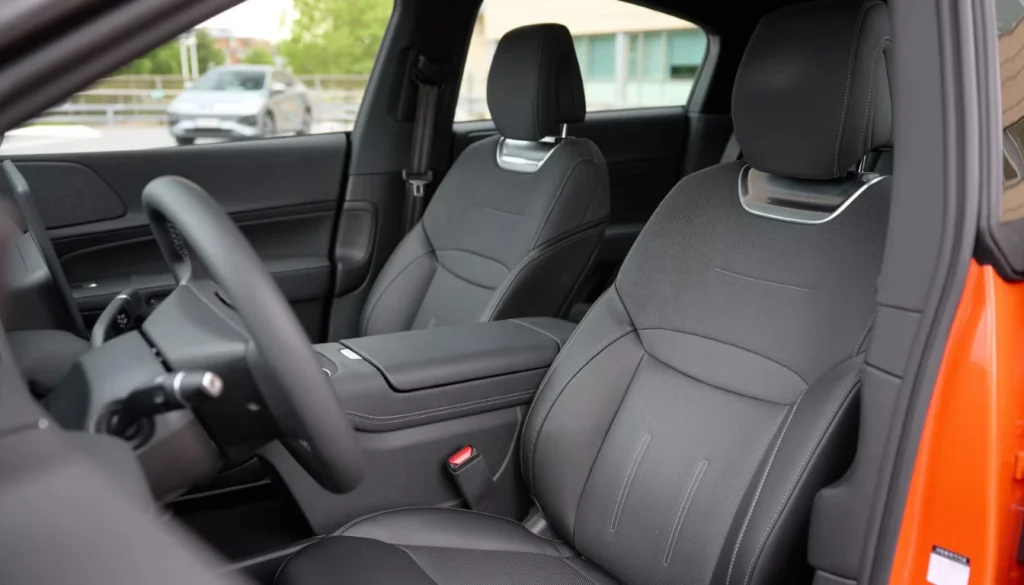As a Tesla Model Y owner since 2022, I recently had the chance to spend four days testing its Chinese rival, the Xpeng G6. After four days of hands-on testing, it’s time to deliver a no-nonsense evaluation of this formidable new contender. Here is my opinion.


This comparison makes perfect sense because the G6 does not hide its ambition to be a “Tesla killer”, this 100% electric SUV takes many of the codes of the American manufacturer while trying to do better on several points.
Very close to Tesla
Honestly, switching from my Model Y to the G6 is a bit like switching from an iPhone to a very good Android smartphone: everything is where you expect it to be, even if it’s slightly different. XPeng didn’t play the sorcerer’s apprentice – they looked at what worked well in Tesla and adapted it, sometimes for the better. The general layout, the menus, the essential controls… everything is designed so that a Tesla owner can find their way around immediately.
The driving controls? It’s a clever copy and paste: same position of the gear lever on the right switch, same logic for the turn signals, same approach to managing regeneration under braking. And you know what? That’s all the better! Why try to reinvent the wheel when it already performs flawlessly? This familiarity allowed me to feel comfortable from the first minutes.
I found this familiarity reassuring, it allows immediate handling for any Tesla user. It’s also the same on the Volvo EX30, for your information.

Autopilot is perhaps the most obvious example of this successful inspiration. Xpeng has taken the basics that make the Tesla system successful – activation by double-clicking on a switch, similar visualization interface, same logic of use – while bringing its own improvements and better management of temporary deactivations.
Even the driver assistance settings follow a similar logic. It’s a smart choice: why complicate what already works well?
It’s true, when I arrive in front of the Xpeng G6, my first impression is mixed. Its design is less refined than my Model Y, with more conventional lines. Maybe the flocking has something to do with it, but I’m not entirely convinced by its lines.
A very successful interior
But once you’re inside, the picture changes radically. The cabin exudes quality, with materials and assemblies that are clearly superior to my Tesla. This is the first point that struck me: Xpeng has not skimped on perceived quality.
The G6’s seats are a real success. Ventilated at the front (a plus that Tesla does not currently offer), they offer remarkable support and comfort. The soundproofing is amazing, clearly better than my Model Y, especially on the highway. This is an important point for long journeys.

The 15-inch central screen is reminiscent of Tesla‘s, but the interface is less fluid. It remains, however, much more fluid than anything offered by the others. On the other hand, the presence of Apple CarPlay and Android Auto is a real plus. I can’t count the number of times I’ve complained about their absence in my Tesla.
The driver display behind the steering wheel is also appreciable, although its quality could be better. I would have liked to have a head-up display, which is found on quite a few German and even Chinese models (Nio, BYD, Xiaomi, etc.).
The great strength of the Xpeng G6 interface is its very complete application ecosystem. In addition to the fluid and responsive native system, I discovered a real application store, something that I only knew from Google Automotive until now (in France).
You can install Apple TV, Disney+, YouTube, TikTok or Instagram. While most of them are (I think) actually web apps optimized for the interface, their integration remains convincing. This is a step forward compared to Tesla, which keeps its system closed.
There are still some areas for improvement, though. Translations are sometimes rough, some apps can be used while driving (like Apple TV), which is very dangerous, and I noticed some minor display bugs.
The overall fluidity, although very correct, does not yet reach the level of Tesla. But regular updates show that Xpeng is actively working on improving the system.
More than a copy of Tesla, Xpeng offers a different approach: where Tesla wants to control everything, the G6 offers an open and versatile platform. The system is already more advanced than what traditional manufacturers offer, and some features (like the app store) even surpass Tesla.
At the wheel
Technically, the G6 really plays in the same league as my Model Y. In the city, on the road or on the highway, the consumptions are almost identical.
Behind the wheel, the G6 stands out from my Model Y by a more consensual character. The accelerations are less brutal (even in Sport mode), but the driving comfort is superior. The suspensions filter the imperfections of the road better. It is more family-friendly, less sporty. The steering is more flexible.
Fast charging, often the weak point of Chinese manufacturers, is amazing here. With its 800V platform, the G6 even does better than my Tesla on certain points. The charging curve is well controlled, with a long high-power plateau. This is the kind of performance we expected here.
Autopilot not far from perfection
The Xpeng G6’s Autopilot (called XPilot) particularly impressed me with its ability to stay active in situations where my Tesla’s would deactivate. This is particularly evident when changing lanes: whereas my Model Y would cut off Autopilot as soon as I activated the turn signal to pass, the G6 kept the system active.

Once the maneuver is complete, it reactivates instantly. This fluidity of use makes long journeys much more relaxing. The steering wheel is very responsive, and this is also a real plus: no need to exert a slight force on the steering wheel like on Tesla, a simple contact of the hand is enough. Not sure if it is capacitive, but it is just like it. (update: I have been confirmed, it is indeed capacitive)
Safety is not left out. The XPilot is very careful, perhaps even too careful at times. Detection of surrounding vehicles is excellent, and the system maintains comfortable safety distances.
Automatic lane changes are particularly well managed: the car waits until it has enough space before starting the maneuver, unlike some competing systems that are sometimes too aggressive. Centering in the lane is precise, without the small oscillations that can sometimes be felt on other systems.
There is, however, one point that could be improved: the management of bends on the road. The system tends to slow down excessively when approaching slightly pronounced bends, sometimes up to 20-30 km/h below the set speed. While this is reassuring in terms of safety, it can become annoying on winding roads and create unnatural situations with the cars following.
The sound quality is amazing
As an audiophile and a big music consumer while driving, the audio system is important to me. Xpeng has done a remarkable job with its 960-watt Xopera system made up of 18 speakers. The setup is impressive on paper: 7 main speakers distributed throughout the cabin, a subwoofer in the trunk, 4 speakers in the roof lining for immersion, and a unique speaker system integrated into the front headrests. This 7.1.4 architecture is reminiscent of a high-end home theater installation.

The sound quality is amazing, far superior to that of my Tesla Model Y. The bass is deep but controlled, the mids are precise and the highs are crystal clear without being aggressive. The active noise reduction system, coupled with the excellent soundproofing of the car, creates a perfect sound bubble. Even at high volumes, I didn’t detect any distortion.
The sound distribution is even throughout the cabin, and the soundstage is wide and deep. The DSP (digital signal processor) does an excellent job of adapting the sound to the speed of the vehicle.
The most surprising feature is the integration of speakers into the front headrests. When making phone calls or using the voice assistant, the sound is directed only to the driver via these speakers. This is a real plus in everyday life: other passengers are not disturbed by conversations or navigation instructions, and the call quality is significantly improved thanks to the proximity of the speakers. The voice assistant is also easier to understand. It’s this kind of thoughtful detail that shows that Xpeng has really thought about the user experience as a whole.
The voice assistant is bad
The voice assistant is probably one of the most disappointing points of the Xpeng G6. Stuck in English for the moment, it struggles to understand the most basic commands, even with a correct accent. Simple commands like adjusting the temperature or changing the radio station become an exercise in patience, often requiring several attempts before being understood. This is all the more frustrating since the car has excellent microphones integrated into the headrests, which could have been used for better voice recognition.
This weakness is all the more surprising since Xpeng’s voice assistant is one of the brand’s strong points in China, where it is renowned for its responsiveness and advanced understanding. Other Chinese manufacturers such as Nio have managed to offer high-performance voice assistants. Xpeng seems to have underestimated the importance of linguistic adaptation for the European market. The contrast is striking with my Model Y which, without being extraordinary, at least offers a correct understanding of basic commands in French.
The benchmark in the field remains Google Assistant, which can be found at Renault or Volvo. Even Tesla, although at the forefront in many aspects, cannot compete with the relevance and natural understanding of the Google Assistant. For now, it is better to be satisfied with physical controls or the touch screen.
An imposing size, thanks to the helpers

The dimensions of the G6 are questionable for everyday use. At 4.75 meters long and 1.92 meters wide, it exceeds the Model Y by 5 centimeters in each dimension. This difference may seem minimal on paper, but it is felt in everyday life, especially in underground parking lots or narrow streets in city centers.
Even more surprisingly, despite its imposing size, the G6 offers less trunk space than the Model Y. On the other hand, the rear habitability is generous, which reflects the preferences of the Chinese market where the comfort of rear passengers often takes precedence over loading capacity.
For use in France, where storage volume is an important purchasing criterion, this is a compromise that may give food for thought.
The maneuvering aids more than compensate for these generous dimensions. The G6’s 360° camera system is remarkably well thought out, with a high-definition display and a panoramic view that activates automatically when approaching obstacles. The images are clear, well zoomed in at strategic locations, and the parking radars are precise. The front camera, often absent on other vehicles, is particularly useful in parking lots or when faced with low obstacles.
The system is proactive: as soon as you approach a wall, a pole or another obstacle, the cameras are automatically activated with an intelligent zoom on the area concerned.
The dynamic guidance lines and real-time distance displays make maneuvering surprisingly easy for a vehicle of this size. It’s a far cry from Tesla’s system, which only provides a more basic view. This advanced assistance turns what could be a handicap—the car’s size—into a nearly stress-free experience.
Autopark is a success
The AutoPark function of the XPeng G6 is a success. Unlike some systems that fumble or hesitate, the G6’s quickly identifies available spaces and executes maneuvers with precision.
The system is particularly effective in parallel parking, which it performs smoothly.
Multiple high-definition cameras and radars provide clear visualization of the surroundings, and the car displays its planned trajectory in real time.
I was impressed by its ability to handle relatively tight spaces, where my Model Y would probably have given up. It’s clearly more accomplished than what Tesla offers.
So, are we switching to an Xpeng G6?
You want to know if I would give up my Model Y for a G6? I seriously asked myself the question.
The comfort is just amazing, you would think you were in a premium German car. The little extras really make the difference: seats that ventilate in the summer (a real pleasure), phone chargers that cool, and a very convincing audio system. In terms of price, even without an ecological bonus, it remains interesting. And yes, I admit it, the idea of no longer having to explain Elon’s latest tweets at every dinner has its charm. Xpeng arrives with a solid proposition: as tech as Tesla, but wiser.

But there are a few things that make me tick. Xpeng has just arrived in France – what is the after-sales service like? If I want to resell in 3 years, how much do I lose? They promise updates to fix bugs, ok, but when? The voice assistant that only understands English is a pain on a daily basis. And their Autopilot slowing down on bends while my Tesla negotiates them calmly can quickly become annoying. Not to mention the smaller trunk – weird for a bigger car, right?
For now, I’m keeping my Model Y. But I’m keeping an eye on XPeng. If they can build a real network in France and fix these little flaws, it could become very interesting. For a first attempt on our market, it’s already pretty impressive. Tesla should start worrying – the Chinese competition is there, and it’s learning fast.